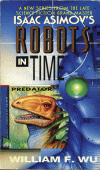This book is great for teens, not for adult readers or die-hard fans. I acquired this book along with about 16 Isaac Asimov classics (Foundation series, Caves of Steel, etc), otherwise I probably never would have purchased it. If you are a die-hard fan like me, you will find this book/series unbearable. The book is written for a young reader according to the author, so my reaction is to be expected. The main characters act out every single 3 law conflict over and over throughout the novel. Every situation is explained in detail with reason why Robot X can or can’t do this or that because of Law X.
For a new reader that isn’t familiar with Asimov this book would probably be very informative. If you are interested in Time travel, buy “The End of Eternity” by Isaac Asimov. If you want to read up on the Three Laws, buy “I, Robot”. If you want a combination of both for a younger reader, buy this book. I would suggest this book for readers around the age of 12-16 after they have read “I, Robot”.


